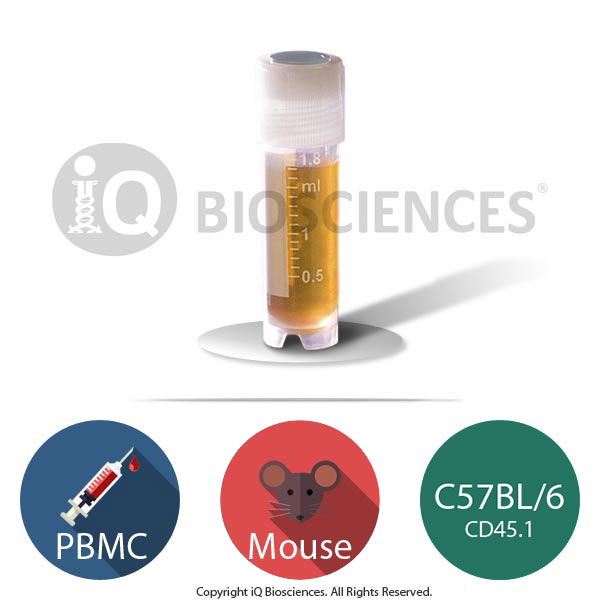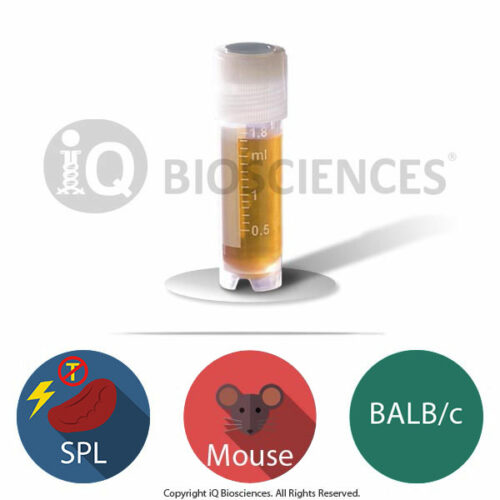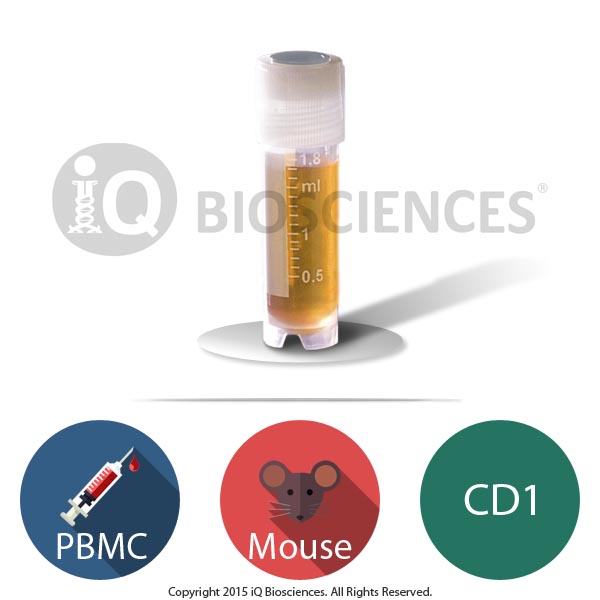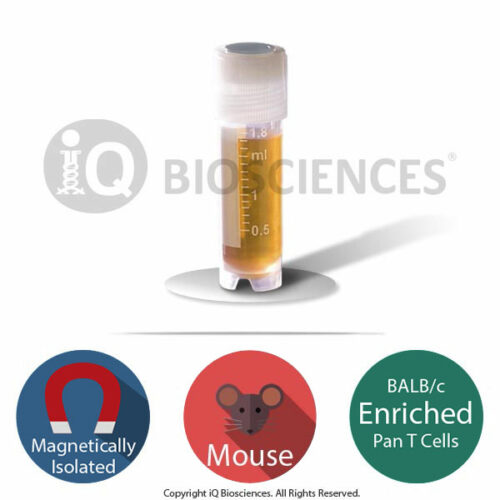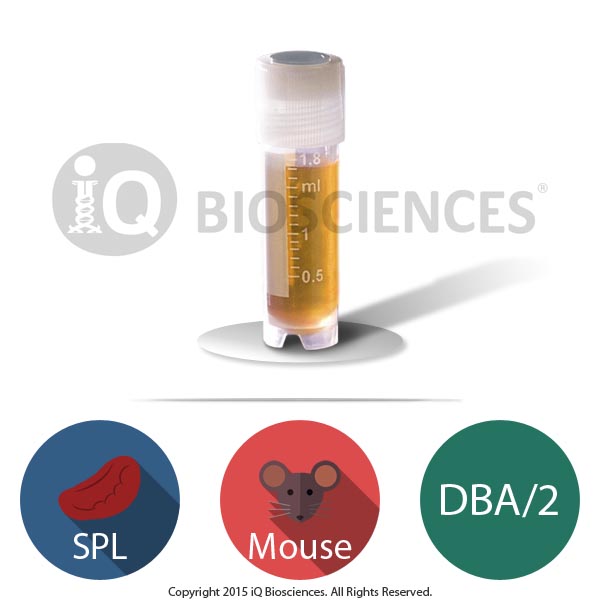- High-quality CD45.1 Peripheral Blood Mononuclear cells (PBMCs) from C57BL/6 congenic mice
- High viability (> 80%) after thawing
- Used for a wide variety of immunology-based co-culture applications or in vivo adoptive transfer studies
- All orders come with an iQ Certificate of Analysis
- Normally ships out same business day
CD45.1 C57BL/6 Mouse Peripheral Blood Mononuclear Cells (PBMCs)
$500.00
Description
CD45.1 C57BL/6 Peripheral Blood Mononuclear cells (PBMCs)
CD45.1 PBMCs come from C57BL/6 congenic mice that express the CD45.1 allele. CD45 itself is a protein tyrosine phosphatase receptor expressed on all hematopoietic cells except mature erythrocytes and platelets and is encoded by the Ptprc gene. Wild-type C57BL/6 mice normally carry the Ptprcb (CD45.2) allele while the other (congenic) strain carries the Ptprca (CD45.1) allele on the same C57BL/6 genetic background.
Application Summary for CD45.1 and CD45.2 Cells
CD45.1 and CD45.2 cells are widely used in transplant and adoptive transfer studies to track the donor and host cells through the different alleles. In most transfer experiments, leukocytes expressing CD45.1 are transferred into wild-type C57BL/6 mice and then identified using an antibody specific for CD45.1. Similarly, cells expressing CD45.2 can be distinguished using antibodies that recognize CD45.2.
Cells from congenic mice that are genetically engineered (knockout or transgenic mice) can also be used in in vitro experiments to track cell development. Cells from knockout mice on a CD45.1 background can be mixed in culture with CD45.2 wild-type cells to understand the role of that specific gene in cell lineage fate decisions in a wild-type environment. Similar to the animal studies, antibodies against CD45.1 and CD45.2 can be used to distinguish the origin of the cells and track their outcomes. These experiments are faster and easier to perform and analyze compared to animal transfer studies.
Isolation of CD45.1 PBMCs
Peripheral blood collection and PBMC Isolation
PBMCs from non-human organisms are isolated from peripheral blood collected responsibly at third party facilities. These facilities are vetted to ensure they operate according to local regulations and laws. Since the facility is local, the blood is quickly transported to iQ’s facility for processing.
PBMCs are specifically isolated by performing a density centrifugation at room temperature to remove red blood cells. iQ Biosciences performs this process under sterile conditions by using Ficoll, a high molecular weight sucrose solution from GE Healthcare. The result is a perfect layer of mononuclear cells that are separated from plasma, platelets, granulocytes, and erythrocytes. Additional quality control steps are taken to isolate and prepare PBMCs that ensure the highest viability for cryopreservation and downstream experimental applications.
Expression of CD45.1
A small aliquot of cells was tested for CD45.1 by flow cytometric analysis. Expression of CD45.1 was > 99%.
Cryopreservation and storage
CD45.1 PBMCs were cryopreserved carefully using iQ Biosciences’ cryopreservation protocol that ensures high viability (> 80%) after thawing.
Cells should be stored at <-120°C once they are received, such as within a liquid nitrogen tank (vapor phase).
Additional information
| Available Size(s) | |
|---|---|
| Cell Type | |
| Format | |
| Species | |
| Tissue Type | |
| Viability | > 80% |
For US customers, we ship via FedEx Overnight Shipping. Shipping charges will vary per shipping address (based on ZIP code) and are estimated to be $140.
For international (non-US) customers, we work closely with you and our couriers to ensure all necessary documentation is in place for international shipments to significantly reduce the chance of delays at Customs. For the export of non-human primate samples, this includes preparing CITES permits, as well as any other documentation as required by country. Please submit an inquiry to orders@iqbiosciences.com for your estimated time of delivery and shipping charges.
Austria
Hölzel Diagnostika Handels GmbH
Tel: +49 221 126 02 66
Email: info@hoelzel.de
Web: https://www.hoelzel-biotech.com/
Canada
Cedarlane
Tel: +1 (289) 288-0001
Toll Free (North America): +1 (800) 268-5058
Fax: +1 (289) 288-0020
Email: sales@cedarlanelabs.com
Web: https://www.cedarlanelabs.com
China
BIOHUB INTERNATIONAL TRADE CO., LTD.
上海起发实验试剂有限公司
Address: Chuansha Rd #6619, Pudong, Shanghai, Zipcode: 201200 P.R.China
Tel: 0086-021-50724187
Phone: +86-15921799099
Fax: 0086-021-50724961
Email: sale3@78bio.com
Web: www.qfbio.com
European Union
Caltag Medsystems Ltd.
Email: office@caltagmedsystems.co.uk
Web: https://www.caltagmedsystems.co.uk
tebu-bio
Web: https://www.tebu-bio.com
Or Find a local contact
Germany
Hölzel Diagnostika Handels GmbH
Tel: +49 221 126 02 66
Email: info@hoelzel.de
Web: https://www.hoelzel-biotech.com/
Zageno
Web: https://zageno.com/
Ireland
2B Scientific Ltd
Tel: +44(0) 1869 238033
Fax: +44(0) 1869 238034
Email: sales@2BScientific.com
Web: https://www.2bscientific.com
India
Cell & Gene BioSolutions Pvt. Ltd.
#478 C, SLV Complex, Raghavendra Swamy Mutt Road
Opp. Turahalli Water Tank, Turahalli, Subramanyapura Post
Uttarahalli Hobli, Bengaluru-560061, Karnataka, India
Phone: +91 97317 14670
Phone: +91 98809 25033
Email: info@cgbios.com
Web: www.cgbios.com
Japan
Cosmo Bio Co., Ltd.
Tel: +81 (03) 5632 9610
Fax: +81 (03) 5632 9619
Email: nsmail@cosmobio.co.jp
Web: https://www.cosmobio.co.jp
Qatar
Sedeer Medical Services and Trading LLC
Tel: +974 4434 9191
Email: info@sedeer.com
Web: https://sedeer.com/
Singapore
Omnicell Pte Ltd
Tel: +65 6747 0201
Email: enquiry@omnicell.com.sg
Web: https://omnicell.com.sg/</a
South Korea
BioClone
Tel: +82-2-2690-0058
Email: bioclone@bioclone.co.kr
Web: http://www.bioclone.co.kr
Switzerland
Hölzel Diagnostika Handels GmbH
Tel: +49 221 126 02 66
Email: info@hoelzel.de
Web: https://www.hoelzel-biotech.com/
Taiwan
Hycell International Co. Ltd.
Tel: +886-2-2877-1122
Fax: +886-2-2876-1520
Web: http://www.hycell.com.tw
United Kingdom
2B Scientific Ltd
Tel: +44(0) 1869 238033
Fax: +44(0) 1869 238034
Email: sales@2BScientific.com
Web: https://www.2bscientific.com
Caltag Medsystems Ltd.
Tel: +44 (0)1280 827460
Fax: +44 (0)1280 827466
Email: office@caltagmedsystems.co.uk
Web: https://www.caltagmedsystems.co.uk
tebu-bio
Tel: +44 (0)1733 421880
Fax: +44 (0)1733 421882
Email: uk@tebu-bio.com
Web: https://www.tebu-bio.com
Zageno
Web: https://zageno.com/
United States
Fisher Scientific
Tel: 1-800-766-7000
Web: https://www.fishersci.com
Quartzy
Web: https://www.quartzy.com
VWR International
Tel: 1-800-932-5000
Web: https://www.vwr.com
Zageno
Web: https://zageno.com/
